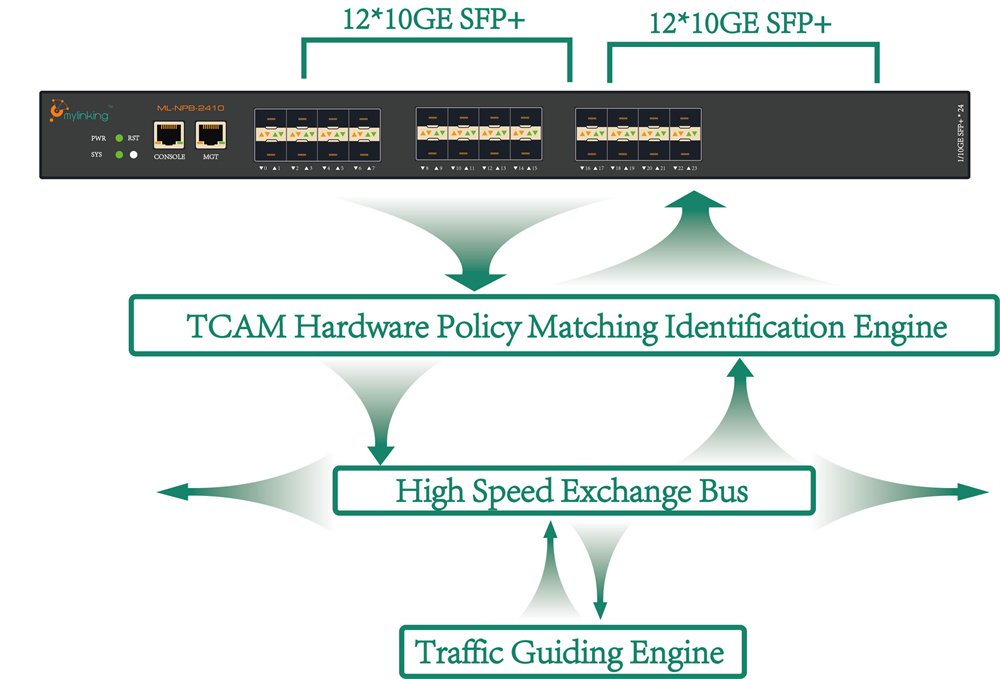1- Overviews
- A full visual control of Data Acquisition device(24*10GE SFP+ ports)
- A full Data Scheduling Management device(duplex Rx/Tx processing)
- full pre-processing and re-distribution device(bidirectional bandwidth 240Gbps)
- Supported collection & reception of link data from different network element locations
- Supported UDF matching, the user-defined packet offsets and key fields, and more accurately guides the output of data that the user cares about.
- Supported real-time the health status detection(port health check) of the back-end monitoring and analysis devices service process, which connected to different output ports. When the service process fails, the faulty device is automatically removed.
- Supported to automatically recognizes multi-layer MPLS and multi-layer VLAN TAG tags, and implements traffic output policies based on user configurations based on features such as MPLS Lable, MPLS TTL, VLAN ID, and VLAN Priority.
- Supported automatically identify various tunneling protocols such as GTP/GRE/PPTP/L2TP/PPPOE, and the implement traffic output policies based on the inner or outer layer characteristics of the tunnel.
- Traffic splitting policy supports data packet filtering and matching, including quintuple-based (source IP, destination IP, source port, destination port, protocol number), and packets.

2- System Block Diagram

3- Operating Principle

4- Intelligent Traffic Processing Abilities
6- Specifications
| ML-NPB-2410 Mylinking™ Network Packet Broker TAP/NPB Functional Parameters | ||
| Network Interface | 10GE | 24*10GE/GE SFP+ slot; support single/multiple mode fiber |
| Out-of-Band MGT interface | 1*10/100/1000M electrical port | |
| Deploy mode | 10G optical splitting | Support 12*10G bidirectional link traffic acquisition |
| 10G mirror acquisition | Support max to 24*10G mirror traffic inputting | |
| Optical inputting | Input port supports single fiber splitting input; | |
| Port multiplexing | Support input port as output port; | |
| Flow output | Support 24 channels of 10GE flow output; | |
| Traffic aggregating/replicating/distribution | Supported | |
| QTYs of links supporting traffic duplicating/aggregating | 1->N way traffic replication (N<24) N->1 channel traffic aggregation (N<24) Group G (M->N way) grouped traffic replication aggregation [ G*(M+N) < 24 ] | |
| Port-based traffic identification diverting | Supported | |
| port five tuple traffic identification diverting | Supported | |
| Traffic identification divert strategy based on key tag of protocol header | Supported | |
| Ethernet encapsulation unrelated support | Supported | |
| CONSOLE MGT | Supported | |
| IP/WEB MGT | Supported | |
| SNMP MGT | Supported | |
| TELNET/SSH MGT | Supported | |
| SYSLOG protocol | Supported | |
| User authentication | Based on users’ password authentication | |
| Electric(1+1 Redundant Power System-RPS) | Rate power supply voltage | AC110-240V/DC-48V(Optional) |
| Rate power supply frequency | AC-50HZ | |
| Rate input current | AC-3A / DC-10A | |
| Rate power | 140W/150W/150W | |
| Environment | Working temperature | 0-50℃ |
| Storage temperature | -20-70℃ | |
| Working humidity | 10%-95%, no condensation | |
| User Configuration | Console configuration | RS232 interface, 9600,8,N,1 |
| Password authentication | Supported | |
| Height of Chassis | (U) | 1U 445mm*44mm*402mm |
7- Order Information
ML-NPB-0810 mylinking™ Network Packet Broker 8*10GE/GE SFP+ ports, max 80Gbps
ML-NPB-1610 mylinking™ Network Packet Broker 16*10GE/GE SFP+ ports, max 160Gbps
ML-NPB-2410 mylinking™ Network Packet Broker 24*10GE/GE SFP+ ports, max 240Gbps
FYR: Packet Fitering of Mylinking™ Network Packet Broker
Packet Filtering Through the inspection module, the firewall can intercept and check all outbound data.The firewall inspection module first verifies whether the packet conforms to the filtering rules. Regardless of whether the packet conforms to the filtering rules, the firewall shall record the packet situation, and the packet that does not conform to the rules shall alarm or notify the administrator.Depending on the packet filtering strategy, the firewall may or may not send a message to the sender for dropped packets.The packet checking module can check all the information in the packet, generally the IP header of the network layer and the header of the transport layer.Packet filtering generally checks for the following items:
- IP source address;
- IP destination address;
- Protocol types (TCP packets, UDP packets and ICMP packets);
- The source port of TCP or UDP;
- The destination port of TCP or UDP;
- ICMP message type;
- The ACK bit in the TCP header.